Competitiveness in the Electronics Industry of Mexicali Affected by Atmospheric Corrosion
La competitividad de la industria electrónica afectada por la corrosión atmosférica
Competitiveness in the Electronics Industry of Mexicali Affected by Atmospheric Corrosion
Científica, vol. 20, no. 2, pp. 71-76, 2016
Instituto Politécnico Nacional
Received: 29/10/15
Accepted: 24/05/16
Abstract: The electronics industry has grown over the past fifty years, especially in developed countries, contributing to its economy. In particular, Baja California that is located in northwestern Mexico, have industrial parks with companies in other countries, mainly of United States, Japan, Germany, South Korea and China. In this State, is located Mexicali city, on the US border, where a large number of industrial plants was installed, with 80% of electronic trade industries, and the rest (20%), has electronic devices and systems in the industrial equipment and machinery. Based on this, a study was conducted to determine the main types of electrical faults and organize the main causes of reduced operating performance of equipment and electronic machinery, using the ABC graphs and together with the software Matlab graphics. The analysis showed that the operating performance was lower in some summer and winter periods, and when levels of relative humidity and temperature were higher than 75% to 30 ° C, and presence of sulfides concentrations exceeded the air quality standards, causing atmospheric corrosion. Index terms: competitiveness, electronics industry, atmospheric corrosion. La competitividad de la industria electrónica afectada por la corrosión atmosférica
Keywords: competitiveness, electronics industry, atmospheric corrosion.
Resumen: La industria electrónica ha crecido en los últimos cincuenta años, sobre todo en los países desarrollados, contribuyendo a su economía. En particular, en Baja California que se encuentra en el noroeste de México, tienen zonas industriales con empresas de otros países, principalmente de Estados Unidos, Japón, Alemania, Corea del Sur y China. En este lugar de la república mexicana, se encuentra la ciudad de Mexicali, en la frontera con Estados Unidos, donde se instaló un gran número de plantas industriales, siendo 80% del ramo electrónico y 20% de otra índole; en general, las empresas instaladas en esta ciudad tienen dispositivos y sistemas electrónicos utilizados en equipos y maquinaria industrial. En la industria electrónica de esta ciudad, los equipos y maquinaria industrial, tienden a reducir su rendimiento operativo por la exposición a la corrosión atmosférica. Esto genera fallas eléctricas de forma continua o en determinados momentos. Con base en esto, se realizó un estudio para determinar los principales tipos de fallas eléctricas y, así, organizar las principales causas de reducción del rendimiento operativo de los equipos y maquinaria electrónica, utilizando la gráfica ABC junto con el software Matlab. El análisis mostró que el rendimiento operativo fue menor en algunos meses de verano y de invierno con índices de humedad relativa y temperatura superior a 75 y 30°C y concentraciones de sulfuros que excedieron el estándar de calidad de aire, originando la corrosión.
Palabras clave: competitividad, industria electrónica, corrosión atmosférica.
1. Introduction
The electronics industry is considered as one of major industries of the world, and is a factor of interest in the economy of each country with companies engaged in the manufacture of electronic products and companies that manufacture other products with electronic devices and systems, used by industrial equipment and machinery [1]. In these type of companies, are utilized methods and techniques to evaluate the operating yielding, with statistical methods such as the ABC analysis graphs coupled in the MatLab software [2]. This study showed that the generation of the electrical failures were occurred by the presence of the atmospheric corrosion and appeared the decrease of competitiveness of the company evaluated. The electronic devices and systems, used in the industry evaluated, contained a variety of microelectronic devices and its operations, and were affected by the corrosion phenomena. If the functionality of some of these electronic components decreased, then the industrial equipment and the industrial machinery, decreased; and these systems were affected in its operational yielding [3], [4]. The sulfides penetrated by holes and cracks of walls, or roofs, and also by the air conditioning systems and even sometimes by the filters that are placed in the constructions of these companies, and its pollution agents, reacted with the metallic surfaces of electrical connections of electronic devices and systems, generating the corrosion process [5], [1]. Because of this, corrosion was originated and thereby was reduced the operating life time of industrial equipment and machinery, and were stopped working earlier than planned, suggested by the supplier [6], [7].
1.1. Competitiveness in the electronics industry
The creativity is one of the most valued and demanded aspects by companies in the field of the industrial engineering factors. This way is adequate to obtain the quality and quantity in the time required with the generation of new ideas, methods and processes applied to the industry, with a special relation with the engineering and the competitiveness.
1.2. Atmospheric corrosion indoors electronics industry
At higher levels of relative humidity and temperature than 75% and 30 ° C, begins the process of corrosion in indoors of the electronics industry in arid environments such is presented in the summer and winter seasons, which are typical in the Mexicali city. This creates a greater change in the valence state of the metals used in electronic devices, and deteriorates very fast, and with this, were damaged the metallic materials, utilized in the electronics devices and systems of the electronics industry [8],[1]. In the corrosion process, the metallic materials undergo changes and modified its physicochemical properties. This caused electrical failures in the industrial equipment and machinery, and is incremented when the air pollutants mentioned exceeded the air quality indexes. These indices were proposed by the Secretariat of Environment and Natural Resources (SEMARNAT) of Mexico and the Environmental Protection Agency (EPA) of the United States [4].
1.3. ABC Graphics
The Graphics ABC are an important tool in the manufacturing areas of the electronics industry, with the use of statistical methods that provide relevant information on events of interest in operations [9]. The information obtained is concentrated in sections by percentage levels and were evaluated the three main types of groups of data of ABC graphs. This data may be part of the letters of the graphic: "A" area, which is a section of the graph with some data information, and "B" area of the same graphical representation with other type of data information and "C" other area with the last set of data analyzed. The "Graphic ABC" is a graphical representation or Rule 80/20.
2. Methodology
Generation of corrosion inside of the electronics industry in Mexicali, worried to specialized people and managers of these type of companies, because in this study showed that caused economic losses. Based on various problematic situations presented in the company evaluated, a study was developed to specifically determine the main causes of poor operating yielding of the industry analyzed. One of the main tools was the use of the Graphs ABC, with various graphical representations with which the main causes. The investigation was from 2013 to 2014 in three stages:
1) Evaluation of electrical failures. Was made an analysis of the historical data of electrical failures in the industrial equipment and machinery, at level of hourly, daily, weekly, monthly, seasonally and the annually periods, using a program called Scandia Industrial Computer (SIC), linked to a computer to develop remotely and instantly the evaluations in the MatLab software.
2) Analysis of Relative Humidity and temperature. The climatic factors were evaluated with a specialized device containing a digital thermometer and hygrometer (Mendity Instruments Co.), at level of hourly, daily, weekly, monthly, seasonal and annual periods. An instrument of Gasman N-15 was used in conjunction to monitor the sulfides in the same periods, and the corrosion rate with the gravimetric method for determining levels of corrosively with ASTM [10] and ISO standard [11].
3) Evaluation of operation yielding. The main causes of poor operating performance of industrial equipment were determined to sort them according to the level of intensity and occurrence and was made a microanalysis of damaged by corrosion with the technique of scanning electron microscopy was performed metal surfaces with the technique of Scanning Electron Microscopy (SEM).
3. Results
The tables 1, 2 and 3 show the analysis according to the causes of higher level to lower intensity for schedule analysis, daily, weekly, monthly, seasonal and annual. Both the axial machines and radial machines, the defective causes of inoperability they resembled, in the placing of the electronic components in the manufactured products. The tables 1, 2 and 3 accounted the highest percentages of electrical faults in the morning shift and the lowest levels were for the evening hours. This indicated that during the night and early morning, the condensation effect was generated and the increase of at least 1°C to 2°C, in the morning, and the corrosion originated in electrical connections and connectors equipment and electrical and electronic systems of the company analyzed. In the daily evaluations, in the days of beginning and end of week, was observed the presence of the electrochemical phenomenon and was continuously in these days. At weekly, the periods with higher rates of electrical faults were in the weeks corresponding to the months of January, February and November and the months of July and August where HR levels were higher than 80% and less than 30°C of temperature levels. The same was true when analyzing the monthly period when the winter was the key in the generating electrical failures of industrial machinery and at the annual level in 2011, and was the higher rates because every year in the city of Mexicali, where was observed at least a small percentage change from 1% to 3% RH and an increase in summer and winter decrease in at least 1°C in temperature. These small variations, caused the modification of indoor atmospheres of the electronics industry evaluated. The data in Tables 1, 2 and 3, were important to know the performance of the industrial equipment. The electrical failure levels was supported to know the periods of influence and take preventive measures.
3.1. Evaluation of electrical failures
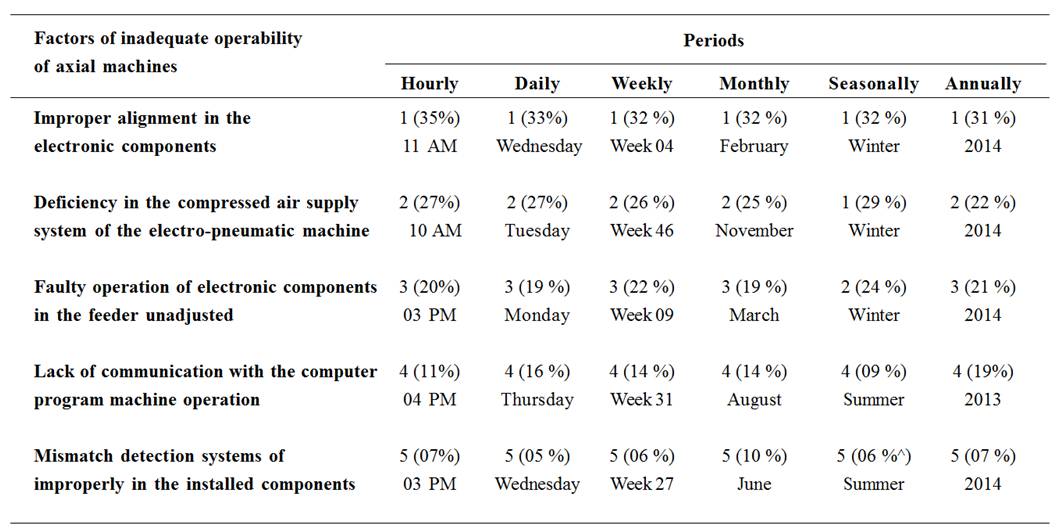
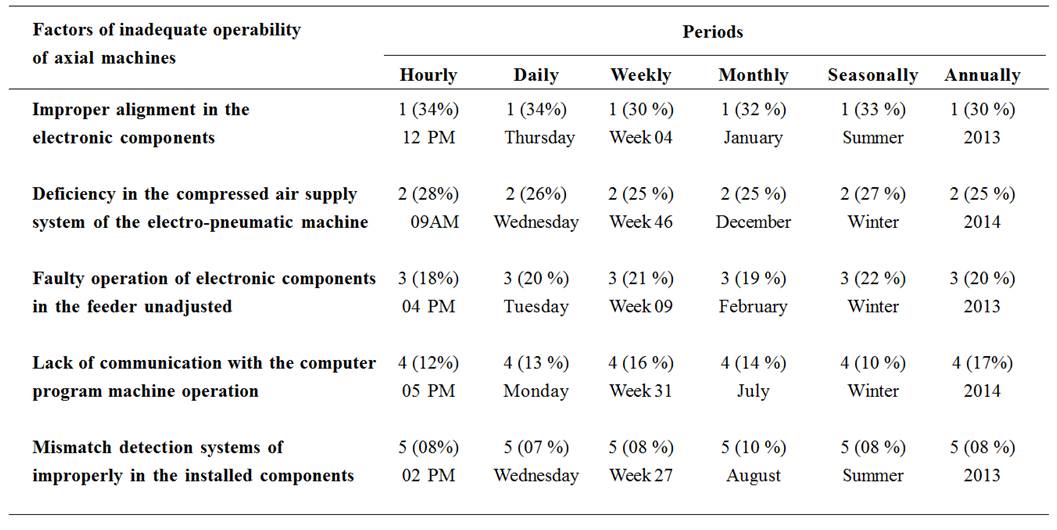
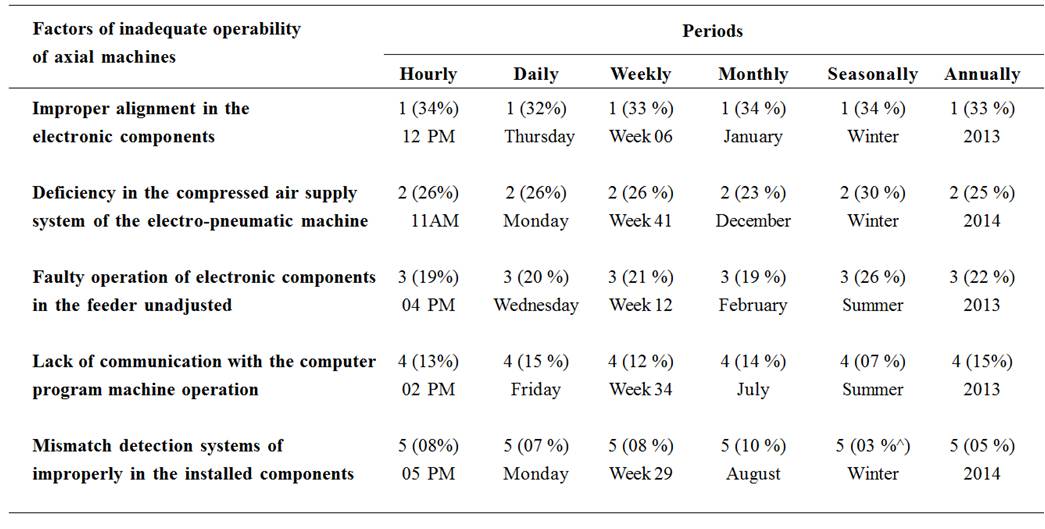
3.2. Analysis with graphics ABC
The evaluations were performed with Graphics ABC, indicating the main types of causes of electrical failures in the industrial equipment and industrial machinery. Figure 1 shows the areas of the graph A, B and C, with the first three types of electrical failures, with the 30% that is the region A, along with the area B coupled to A 69% and completes the analysis area C represents a difference in the area before the end of 31%. Figure 1 is part of the evaluation of the radial machine in the time period, which shows that the first three types of power failures represent 30% which is the area A, and continuing with the region B reaches at 69% and finally reaching the area C, to the total percentage of 100%. Fig. 2 shows the radial percentage rates in the daily period machine, being 28% in zone A, 68% B and in totaling 100%, the region C, indicating that like the previous graphs of the electrical failures in the first three types represent about 70%. Fig. 2 is part of the analysis of the radial machine, showing the monthly period with the percentage levels of 28% in zone A, and then the B region with the 64%, and finally the area C indicating the 100%. In this graph, the differences between areas are contemplated to determine which of the five evaluated types of electrical failures, can be evaluated quickly and easily to phase out gradually the electrical failures that cause the concern of all staff working in this company. Assessments for the winter season in each year of study and in the axial machine were performed, being the electrical failures caused by others factors as minimum level. The analysis in Fig. 3 shows how the percentage rates of radial machine with a weekly evaluation in the region A being 27%, continuing the region B which exceeded 67% (71%) and ending area C which involves 100%.
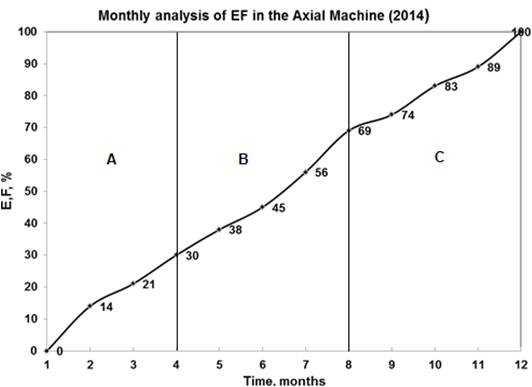
FIG. 1.
Monthly Evaluation of the EF generated in the axial machines (2014).
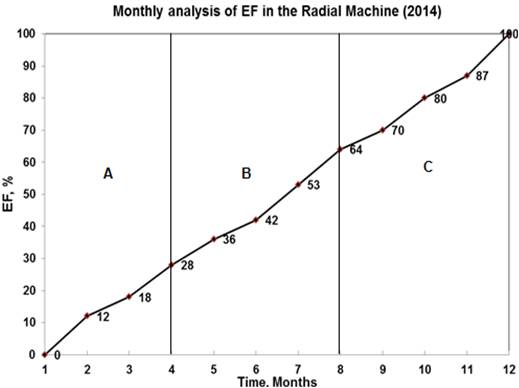
FIG. 2.
Monthly Evaluation of the EF generated in the electrica probe machines (2014).
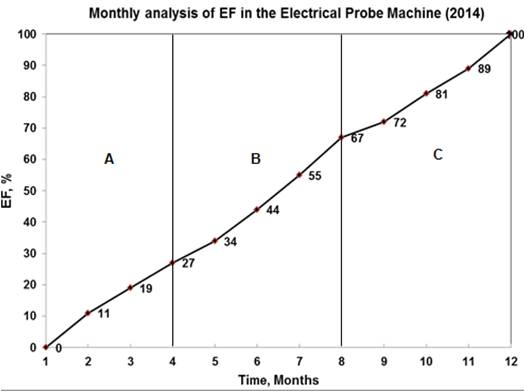
FIG. 3.
Monthly Evaluation of the EF generated in the electrica probe machines (2014).
Once the assessments were made with the Graphics ABC, we proceeded to perform a correlation analysis of the variables of weather, electrical failures and corrosion rate (VC), indicating the degree of deterioration of electrical connections and connectors electronic equipment and systems for the electronics industry.
3.3. Analysis of microscopy
Contaminants that adhered to the metallic surfaces caused the presence of corrosion and their percentages were evaluated through an analysis at the microscopic level where a deterioration in micrographs (Fig. 4) was observed. Fig. 4a showed the damage to the electrical connections of electronic equipment in the summer being a little clear and Fig. 4b is noted for winter obscurely, by the presence of moisture in as many chances. This analysis describes in detail what happens on a microscopic scale.
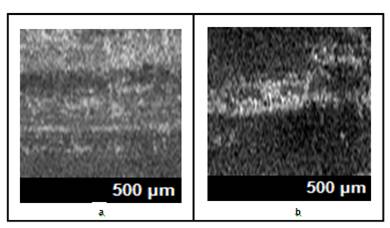
FIG. 4.
Photomicrograph of deterioration of electrical connections of industrial equipment in the era of (a) summer and (b) winter.
5. Conclusions
The ABC graphics used in the manufacturing processes to evaluate the electrical failures by the presence of corrosion, of the electronics industry was a fundamental factor in the detection of the main reasons that cause stoppages of industrial equipment and machinery that used electronic devices and systems, and therefore specialized persons and managers were worried for this. In this study the most important options which originated the lower operating performance of industrial equipment company enabling the study were identified. The effect of corrosion on the deterioration of electrical connections and connectors of electrical and electronic equipment and systems of the company, was an important aspect in the generation of electrical failures. This caused at certain times hourly, daily, weekly, monthly, seasonal and annual of electrical failures, with higher incidence were presented with, which kept alert to the specialized and management personnel, but neglected other operations to be performed.
References
[1] G. López-Badilla, H. Tiznado-Vázquez, and G. Soto-Herrera Gerardo, "Análisis de EEA en la corrosión de cobre utilizado en la industria electrónica de ambientes áridos y marinos," Nova Scientia, vol. 4, no. 7, pp. 1-16, abril, 2012.
[2] G. López, S. Valdez, K. Zlatev, P. Flores, B. Carrillo and W. Schorr, "Corrosion of metals at indoor conditions in the electronics manufacturing industry," Anti-Corrosion Methods and Materials, vol. 54, no. 6, pp. 354 - 359, 2007.
[3] X. Chongchen, "Corrosion in Microelectronics," Partial Fulfillment of MatE, 234, 2003.
[4] G. López-Badilla, "Caracterización de la corrosión en materiales metálicos de la industria electrónica en Mexicali, B.C.," tesis de doctorado, Universidad de Baja California, Mexicali, México, 2008.
[5] L. Veleva, B. Valdez, G. Lopez, L. Vargas, and J. Flores, "Atmospheric corrosion of electro-electronics metals in urban desert simulated indoor environment," Corrosion Engineering Science and Technology, vol. 43, no. 2, pp. 149-155, 2008.
[6] T. Shank and V. Govindarajan, Gráficos ABC: el alto costo de producir, México: Trillas, 2003.
[7] R. S. Kaplan, and R. Cooper, Gráficos ABC: costo y efecto, México: Gestión, 2000.
[8] A. Moncmanova, Environmental Deterioration of Materials, Slovak Republic: WIT Press, 2007.
[9] E. N. Cartier, "El costo basado en actividades y la teoría del costo," Costos y Gestión, no. 11, 1994.
[10] ASTM International, Standard Guide for Measurement Systems Analysis (MSA), ASTM E2782-11e1, 2011.
[11] ISO, Corrosion of metals and alloys - Corrosion of metals and alloys - Classification of low corrosivity of indoor atmospheres - Part 1: Determination and estimation of indoor corrosivity, ISO 11844-1, 2005.
Author notes
glopezbadilla@yahoo.com